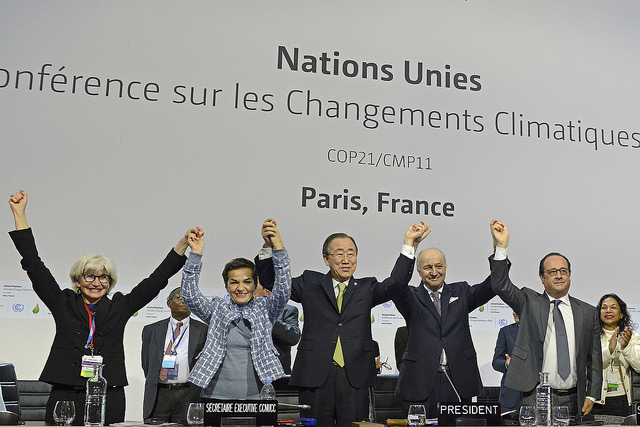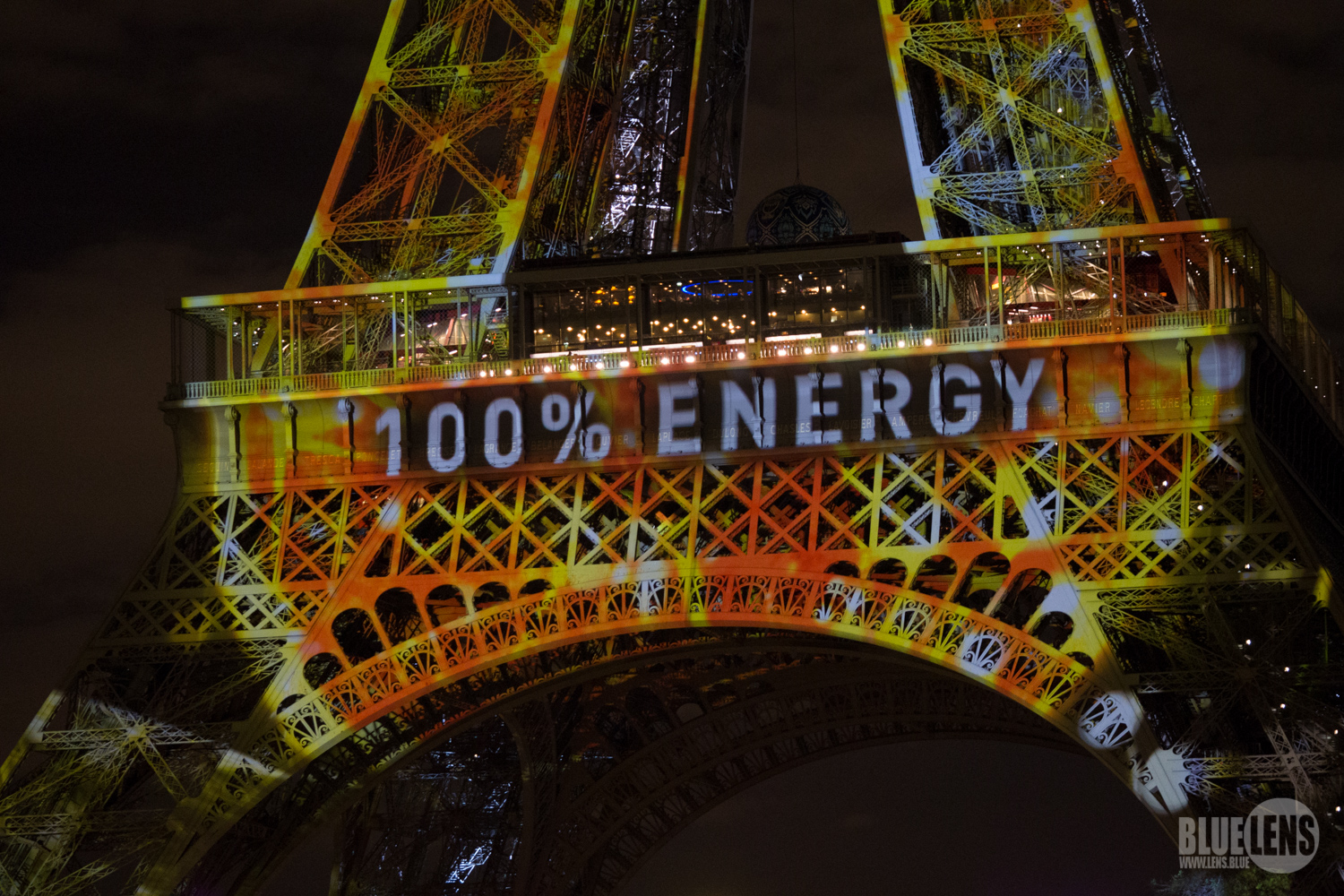COP21 and Free Trade

The adoption of a global climate agreement in Paris at the end of 2015 swept a wave of public optimism towards climate change politics into 2016. There is no critical consensus on the outcome of the Paris negotiations, but the media has left the public idealizing the conjugation of nations as a symbolic moment in history; the end of the fossil fuel era. The public notion that the agreement has symbolic quality, stems from the historic significance: it is the first time that the entire international community of states has pledged to undertake actions to address the global phenomenon of climate change. This, in and of itself, has left the international community politically satisfied, as we now have an international agreement indicating that the global community is uniformly interested in moving away from corrosive energy sources. Yet this quality alone is not sufficient to facilitate the robust political and economic process of global resource and energy technology transfer required to meet the goals of The COP21; prevention of global from rising 2 degrees above pre-industrial levels. Many crucial barriers await and challenge the success of the international agreement beyond the scope of international diplomacy. Furthermore, The Paris Agreement is a legally flawed instrument that will compete with the strong legal instruments of the global free trade system in carving the political and economic path to 2100.

‘Trading’ Significance for Symbolism
Fawcett et al analyzes the road to 2100 with the pledges made in Paris through three potential scenarios and emissions pathways. The Paris scenario, where ambition continues post 2030, illustrates potential implications of the Nationally Determined Contributions (NDCs) component of the Paris Agreement. NDCs were negotiated in Paris as a method where countries choose their own targets by submitting nationally determined contributions that will be reviewed in a facilitative dialog in 2018. The NDCs are to be regularly updated and in review every five years starting in 2023. State pledges are currently assessed by looking at the preliminary “Intended Nationally Determined Contributions” (INDCs) that countries submitted before the summit. The Paris Scenario, with continued ambition, assumes that parties will meet their INDC goals through 2030. The scenario does not consider the probability that each country will successfully implement their goals The question is how, if successfully implemented, these goals would shape potential future options. Under these assumptions, the agreement reduces probabilities of extreme warming and increases the probability of limiting global warming to 2°C this century relative to the non-Paris scenario. Climate Action Tracker’s analysis shows that if contributions are executed in full (if everyone fully implements their INDC plans), the expected rate of climate change decreases to 2.4-2.7°C from 3.3-3.9°C (if everyone was to continue current policies). Thus, the current pledges by states do not even fulfill the COP21 goal of limiting the global temperature increases to 2 degrees celsius. Furthermore, because countries can deviate from their pledges, not only when it is necessary, but also at their own convenience, effective implementation remains highly contingent on the parameters and incentives individual states face. Perhaps the most important parameter is the type and level of energy technology a given country has at their disposal. The cheapest and most reliable energy source in today’s market continues to be fossil fuels. The transfer of a fossil fuel economy onto renewable energy sources can prevent growth and sacrifice GDP in the present, while risking future payoffs due to uncertainty of the outcomes. Furthermore, a state’s choice of energy supply is not an independent factor; it depends on other factors including the industries states are committed to, their bilateral and multilateral trading agreements and partnerships. Bill Gates has announced a public-private project, Mission Innovation, to work alongside the Gates-led investor group, the Breakthrough Energy Initiative, in an effort to aid the development of greener technology. Mission Innovation is a coalition of twenty countries and, involves a number of investors and private individuals who agree to contribute donations (conditional on governmental donation) to work towards advancing the research and development of renewable energy sources. Unfortunately, the global free trade system’s legal strength allows many actors to evade political efforts to curb global climate change. A multinational research effort combining the investments of governments, corporations, and private individuals could create future intellectual property problems and a plethora of Investor-State Dispute Settlements.
A world legally bound to fossil fuels:
The global free trade system influences how states choose their energy, the amount of autonomy a state has to set environmental regulations (which often take the form of protectionist like policies), how much input oil and mining companies have in determining economic regulations, and how/where the products we import and export are produced. Thus, trade agreements are a focal parameter by which states may be more or less likely to commit and effectively implement ambitious national contributions. The Investor State Dispute Settlement (ISDS) mechanism included in the Trans Pacific Partnership investment chapter, grants foreign investors access to a secret tribunal if they believe actions taken by a government will affect their future profits. This provision is lethal to the effectivity of climate policy because many government policies needed to address global warming are subject to suits brought before international investment tribunals. For example, in 2009, Vattenfall (the Swedish energy giant) launched a $1.9 billion (USD) ISDS case against Germany for its decision to delay a coal power station and impose stricter environmental standards. The German government reached a settlement that involved removing additional environmental requirements which enabled the coal plant to begin operating in 2014 in order to avoid massive fees. With the highest carbon content among fossil fuels, coal is a profound threat to the climate. Other TPP chapters, like the one covering trade in goods, can be the basis for state-to-state suits challenging climate policies because, unlike climate policies, they have legal character. Big fossil fuel companies strongly support the TPP because it would encourage a massive expansion of trade in oil, coal, and liquefied natural gas across the Pacific in legal fashion. The TPP would reinforce industry claims that controls on energy exports, which are mandatory to the effective transfer off of fossil fuels, are illegal under international trade and investment law.
The WTO itself is also likely to wreak havoc over the renewable energy transition. In 2009, the subnational government of Ontario enacted a law to incentivize the production of electricity from wind or solar generators that included a scheme to source a minimum level of the component parts and services from producers within Ontario. The WTO panel called Ontario’s electricity system a partially liberalized hybrid system whereby both public and private entities engage in generation, transmission, and distribution. Ontario’s goals were not only to increase the role of wind and solar in the supply mix of electricity, but also to enable new green industries by providing incentives for investment in the manufacturing of renewable energy technology. This violated WTO rule, and the government of Ontario complied with the Dispute Settlement Board’s rulings by no longer subjecting large renewable electricity procurements to domestic requirements. In the Ontario case both public and private engagement in renewable energy plans were deemed illegal. Ontario’s public-private integrated energy plan may remind one of Mission Innovation, which includes 20 states, making up 75% of the world’s CO2 emissions from electricity, with the aid of private investment. Although the logistics of Mission Innovation are yet to be finalized, the global free trade system has the legal ability to prevent a renewable energy research coalition of states and investors if excluded states take legal action on evidence of discrimination. The Investor State Dispute Settlement Mechanism used against Germany, WTO Dispute Settlement Board articles seen in Ontario, and the complexity of WTO Intellectual Property Rights, are all methods by which the global free trade system could legally prevent an effective energy transition.
What is needed: a technology investment
According to the International Energy Agency, the transformation to a fossil-free world will require $1,000 billion per year by 2020. However, the Paris Agreement only commits to ‘mobilizing’ $100 billion per year by 2020 to cover emission cuts, but also adaptation. Meanwhile, the definition of ‘mobilize’ is purposefully broad to include loans, private finance, grants with strings attached, and the reallocation of aid budgets. Thus, the work that Mission Innovation sets to contribute may be pivotal to a successful transition from fossil fuels. The contribution of states and private investors is required to mobilize the appropriate funds for an effective transition. Yet this as a solution remains jeopardized by the legal infrastructure of the global free trade system.
The Copenhagen Consensus on Climate published a book named Smart Solutions to Climate Change, a compilation of research on the viable options for our world. Included is the study, “An Analysis of a Technology-led Climate Policy as a Response to Climate Change”, which traces the failure of climate change policies thus far to the absence of ready and affordable renewable energy sources to replace fossil fuels. This absence, combined with the energy intensive nature of economic growth explains the ineffectivity of brute force mitigation policies: they are extremely economically costly. A technology-led approach to mitigating CO2 emissions and stabilizing climate over the course of the 21st century, focuses policy and governing efforts and commitments on researching and developing effective, scalable, and competitive carbon-emission-free energy technologies to displace carbon-emitting ones. This policy approach proposes a low carbon charge ($5.00/tCO2) to finance long-term commitments to energy R&D. Over time, the charge (tax) would slowly rise (doubling every decade) thereby sending a forward price signal to deploy and diffuse technologies as they “reach the shelf”. This study, alongside the Bill Gates pledge of donations, offers due optimism. If researchers and politicians mobilize in unison by committing to the expansion of available renewable energy sources, effective and continued implementation of the pledges made in Paris is far more likely.
The transition to renewable energy requires strong action and cooperation to meet an agreed-upon carbon tax to fund research and development, but a government’s ability to introduce the right laws and regulations is severely constrained by a very powerful legal system. This international investment regime has ensnared many nations, such as Canada and Germany, in legal nets preventing a transitions to clean energy. National carbon taxes still remain, in the eyes of investors, simply a reduction in profits. While one nation may choose to be ambitious post Paris, committed to research and development to alter their economy, they could be sidetracked by previously struck deals and thus ensnared in the legal power to overrule their ambitions, to the ambitions of multinational corporations. Under free trade agreements, enforcing cross national carbon taxes may be impossible. Furthermore, a coalition such as Mission Innovation as an alternative to a carbon tax but also an assistant form of funding, risks being deemed illegal by the same WTO article’s Ontario has already violated. Mission Innovation and a uniform carbon tax, both effective methods to fund the energy transition, risk being undermined by the legal power of the free trade system. In order for any pledges made in Paris to be committed to effectively, the global free trade system must be monitored closely. Moving forward, nations must suggest carving out the ISDS mechanism from future trade agreements, and appealing for intellectual property rights in the WTO to be relaxed on innovative renewable energy technologies.
The featured image is public domain.

